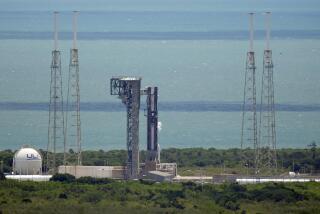Robotic Shuttle Arm Has ‘Tennis Elbow’ : Fixing Satellite Expected to Require 2 Space Walks
- Share via
HOUSTON — It will take two days instead of one for space-walking astronauts to “hot wire” a lifeless satellite because the space shuttle Discovery’s robotic arm is suffering from something akin to tennis elbow, officials said Wednesday.
The extra day probably will require the shuttle to make a rare pre-dawn landing, touching down about an hour before sunrise Tuesday at Edwards Air Force Base in Southern California.
A loss of power to the arm’s elbow will force astronaut John M. Lounge, 39, to physically control the arm by moving levers aboard the shuttle instead of having the computer tell the arm what to do, said Jay Greene, lead flight director for the mission.
The loss of power means that “you do it manually instead of automatically, and you do it a lot slower,” Greene said.
Earlier Start Planned
Astronauts James D. van Hoften, 41, and William F. Fisher, 39, will get an earlier start than had been expected. They are scheduled to begin their space walk Saturday--two days earlier in the mission than originally planned--but they will have to go back outside again Sunday to finish the job, officials believe.
Because of the problem with the mechanical arm, a task that had been expected to take about six hours will probably take about nine and a half hours, according to a spokesman for the National Aeronautics and Space Administration. The maximum acceptable length for a space walk is about six and a half hours.
“It appears we are faced with a two-EVA (extravehicular activity) plan,” said flight director William Reeves.
The second day will also allow time for unexpected problems that may cause other delays.
“Anytime you do an EVA, there’s a ‘gotcha’ out there,” Greene said.
The extra day means that the shuttle should land at Edwards at 5:18 a.m., the second time that the shuttle has made an early morning landing at Edwards.
Shuttle Closing In
The disabled satellite, which has been drifting in orbit since it failed to activate itself after it was released from the Discovery in April, was about 4,000 miles ahead of the shuttle. The Discovery was narrowing the gap by about 50 miles every hour, but that rate of closure will be increased today and Friday by firing the orbiter’s main maneuvering jets several times.
The astronauts must stop the satellite, which is spinning at the rate of about one revolution a minute, and attach two electrical boxes that will allow ground controllers to take command of it.
A satellite that is nearly identical to the disabled one to be repaired was to be deployed by the Discovery early this morning, and NASA officials were hoping that it will go about its business without any help from the ground.
Unlike the disabled satellite, the one to be launched today has been modified to allow ground controllers to take over if its automatic starter fails to get it under way.
The Discovery is commanded by Joe Engle, 53, and the pilot is Richard O. Covey, 39.
Little Else to Do
The five men aboard the shuttle found themselves with little to do Wednesday, other than make preliminary preparations for the space walk.
An Australian communications satellite that was to have been launched Wednesday was launched Tuesday instead because a jammed sun shield would not have protected it from intense solar heat.
Because the sun would have “cooked” the satellite in the shuttle’s open cargo bay, the astronauts moved quickly and deployed it a day ahead of schedule. A few hours later, they became the first NASA crew to deploy two satellites in one day, releasing a second satellite for the American Satellite Co.
Both satellites were reported in good condition Wednesday after firing their main rockets to boost them on toward permanent positions 22,300 miles above the Earth.
More to Read
Sign up for Essential California
The most important California stories and recommendations in your inbox every morning.
You may occasionally receive promotional content from the Los Angeles Times.













